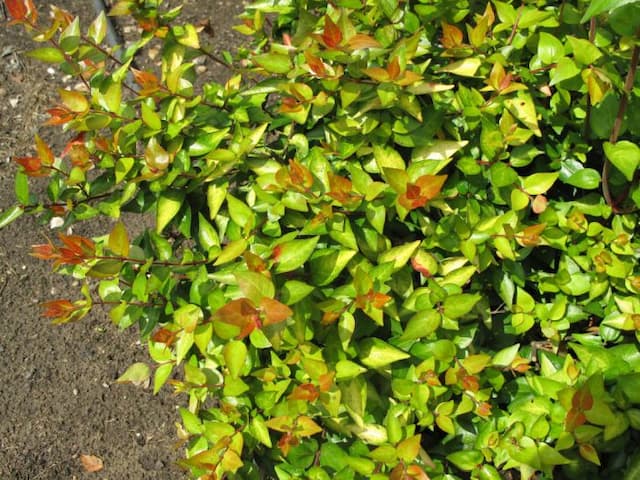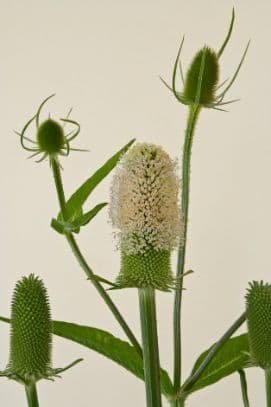Beauty Bush Dipelta floribunda

ABOUT
Dipelta floribunda, commonly known as the Beautiful Dipelta, is a deciduous shrub that carries an air of elegance and delicate charm. This plant is notable for its attractive foliage and gorgeous flowers that make it a standout specimen in a garden setting. The leaves of the Beautiful Dipelta are paired along the branches, displaying a bright green hue that serves as a lovely backdrop to its blooms. The leaves have a simple, ovate shape with finely serrated edges, adding a pleasant texture to the visual display. The true stars of the Beautiful Dipelta are its flowers, which blossom abundantly in the late spring or early summer. The flowers are trumpet-shaped, and they typically come in shades of pink, with a softer, almost white color toward the throat. The blooms boast a distinctive arrangement of five petals, with the outer surface being adorned with velvety hairs that give the petals a subtle shimmer. The flowers often have yellow throats and stamens that protrude elegantly, enhancing the ornamental appeal of the plant. The Beautiful Dipelta's bark and branches also contribute to its aesthetic appeal. The bark is exfoliating, peeling away in strips to reveal a mix of colors that can include shades of tan, brown, and gray. This characteristic adds year-round interest, as the peeling bark creates a lovely texture and pattern that's particularly noticeable during the leafless months. As for the branches, they grow in a graceful, arching manner, which helps create a relaxed and naturalistic shape for the shrub. Despite being cultivated mainly for its decorative features, the Beautiful Dipelta is more than just a pretty face in the garden. It is hardy and adaptable, capable of providing a stunning show each year with minimal care. With its exquisite flowers, pleasing foliage, and interesting bark, the Beautiful Dipelta holds a special allure for garden enthusiasts and is a delightful presence in any landscape where it graces the earth.
About this plant
 Names
NamesFamily
Caprifoliaceae
Synonyms
Beautibush, Dipelta
Common names
Dipelta yunnanensis, Linnaea floribunda, Weigela praecox.
 Toxicity
ToxicityTo humans
Dipelta, a flowering shrub, is not commonly listed as toxic to humans. There are no well-documented cases or research specifying that Dipelta floribunda has toxic effects when ingested by humans. However, it's always prudent to exercise caution and avoid ingesting parts of ornamental plants because their toxicity profile may not be well established.
To pets
Dipelta is not widely recognized as a toxic plant to pets. There seems to be a lack of reported cases and specific research regarding the toxicity of Dipelta floribunda to animals such as dogs and cats. Therefore, there are no known symptoms of poisoning from this plant in pets. Nonetheless, it is generally advised to prevent pets from ingesting plants not intended for consumption as they could potentially cause gastrointestinal upset or other unknown effects.
 Characteristics
CharacteristicsLife cycle
Perennials
Foliage type
Deciduous
Color of leaves
Green
Flower color
Pink
Height
6-8 feet (1.8-2.4 meters)
Spread
6-8 feet (1.8-2.4 meters)
Plant type
Shrub
Hardiness zones
5
Native area
China
Benefits
 General Benefits
General Benefits- Ornamental Value: Dipelta floribunda, commonly known as floribunda shrub, provides ornamental value with its showy, fragrant flowers often used to beautify gardens and landscapes.
- Wildlife Attraction: The plant’s blossoms can attract pollinators such as bees and butterflies, supporting local ecosystems.
- Shade Provider: As a shrub, Dipelta floribunda can contribute to landscaping by offering shade in garden designs.
- Privacy Screen: Its dense foliage makes it useful as a privacy screen or hedge when planted in a row or grouping.
- Adaptable Growth: The floribunda shrub can adapt to a variety of soil types, which makes it a versatile choice for differing garden conditions.
- Seasonal Interest: This shrub adds seasonal interest with its blooms in spring and sometimes colorful foliage in autumn.
- Low Maintenance: Dipelta floribunda is generally considered low maintenance, making it suitable for gardeners of all skill levels.
 Medical Properties
Medical Properties- This plant is not used for medical purposes.
 Air-purifying Qualities
Air-purifying QualitiesThis plant is not specifically known for air purifying qualities.
 Other Uses
Other Uses- Craft and Decoration: Dipelta floribunda branches can be used in floral arrangements and wreaths for their appealing form and foliage.
- Photographic Subject: The plant's showy, pink blooms are often photographed and used in botanical art or as subjects in photography workshops.
- Educational Tool: Botany students and educators can use the plant for study due to its interesting floral structure and pollination strategy.
- Garden Structure: With its arching branches, it can be trained along fences or trellises to create a natural garden screen or divider.
- Wildlife Habitat: The dense foliage provides shelter for birds and small wildlife, while its flowers attract pollinators.
- Ecological Studies: Researchers study the plant's adaptation to its environment and its role in native plant communities.
- Landscape Contrast: Its soft blooms and unique form can provide aesthetic contrast when placed among plants with bold or dark foliage.
- Winter Interest: Even after the leaves fall, the plant's interesting branch structure can provide visual interest in a winter garden.
- Culinary Garnish: While not usually for consumption, the flowers may occasionally be used for decorative garnishes on special dishes.
- Bonsai: Some enthusiasts may use Dipelta floribunda for bonsai due to its attractive flowering and branch structure.
Interesting Facts
 Feng Shui
Feng ShuiThe Dipelta floribunda is not used in Feng Shui practice.
 Zodiac Sign Compitability
Zodiac Sign CompitabilityThe Dipelta floribunda is not used in astrology practice.
 Plant Symbolism
Plant Symbolism- Elegance: With its graceful arching branches and ornate flowers, Dipelta floribunda, commonly known as "Bush Honeysuckle," is often associated with elegance and refined beauty.
- Abundance: The species name 'floribunda' implies 'abundant in flowers,' symbolizing generosity, richness, and a plentiful existence.
- Attraction: As a member of the honeysuckle family, Bush Honeysuckle is known to attract pollinators, symbolizing magnetism and the power to draw others in.
- Protection: In some cultures, honeysuckles are believed to offer protection, which could extend to the Bush Honeysuckle, providing a safe haven for various forms of life.
- Renewal: The ability of the Bush Honeysuckle to rebound and bloom each season signifies renewal, resilience, and the cycle of life.
 Water
WaterThe Sweetshrub, or Dipelta floribunda, requires regular watering to maintain evenly moist soil, particularly during its growing season in spring and summer. Aim to water the Sweetshrub once a week, providing about 1 to 1.5 gallons of water for each plant. Be cautious to not overwater, as standing water can lead to root rot. During the fall and winter, reduce watering to every two weeks or less, depending on local climate conditions, always checking the soil moisture before adding more water. Adjust the frequency if there are prolonged periods of rain or drought.
 Light
LightThe Sweetshrub prefers a spot with full sun to partial shade for optimal growth. It thrives best when it receives at least 4 to 6 hours of direct sunlight per day, but can also tolerate some afternoon shade, especially in hotter climates. Avoid placing the Sweetshrub in deeply shaded areas, as too little light can hinder its flowering and overall health.
 Temperature
TemperatureThe Sweetshrub is hardy and can tolerate a range of temperatures, but it grows best when the temperature is between 60°F and 80°F. This plant can withstand minimum temperatures down to about 20°F and maximum temperatures up to around 90°F. It's important to protect the Sweetshrub from extreme cold winds and abrupt temperature changes which can damage the plant.
 Pruning
PruningPruning the Sweetshrub is essential for maintaining its shape, encouraging healthy growth, and enhancing flowering. Prune immediately after the flowers fade in late spring or early summer, removing any dead or crossing branches to promote air circulation. The Sweetshrub only needs light pruning annually; over-pruning can reduce the number of flowers in the following season.
 Cleaning
CleaningAs needed
 Soil
SoilBeautiful Forsythia prefers well-drained, fertile soil with a pH ranging from 6.0 to 7.5. A good mix would include loamy soil, compost, and peat with a layer of mulch to retain moisture.
 Repotting
RepottingBeautiful Forsythia doesn't require frequent repotting; it is generally repotted every few years as it is a slow grower.
 Humidity & Misting
Humidity & MistingBeautiful Forsythia is adaptable but prefers average humidity levels, similar to what is found in most home environments.
 Suitable locations
Suitable locationsIndoor
Grow Beautiful Forsythia indoors with bright, indirect light and cool temps.
Outdoor
Plant Beautiful Forsythia in sun to part shade and water regularly.
Hardiness zone
5-8 USDA
 Life cycle
Life cycleDipelta floribunda, commonly known as shrubby deutzia, starts its life as a seed, usually dispersed by wind or animals. Upon landing in a suitable location with adequate sunlight and moist soil, the seed germinates and grows into a seedling. As the plant matures, it develops a woody stem and branches, forming a shrub structure. During the spring, shrubby deutzia produces clusters of fragrant, bell-shaped flowers that attract pollinators such as bees and butterflies. After pollination, the flowers develop into small, dry, capsule-like fruits that release seeds, completing the reproductive cycle. The plant continues to grow and produce flowers annually, and with proper conditions, it can live and thrive for many years, adding beauty to the landscape with its foliage and floral display.
 Propogation
PropogationPropogation time
Spring to early summer
The most popular method of propagating Dipelta floribunda, commonly known as the Beautiful Dipelta, is through semi-hardwood cuttings. This is typically done in late summer when the wood is firm and slightly elastic. Cuttings should be around 4 to 6 inches (10 to 15 centimeters) long and include several leaf nodes. Leaves near the base should be removed, and the cut end dipped in rooting hormone to encourage root growth. The cuttings can then be inserted into a pot filled with a well-draining potting mix. It’s important to keep the soil moist and provide a humid environment, often achieved by covering the pot with a plastic bag or dome to retain moisture. Rooting can be expected to occur within a few weeks, after which the young plants can be gradually acclimatized to ambient conditions and eventually transplanted outdoors.








